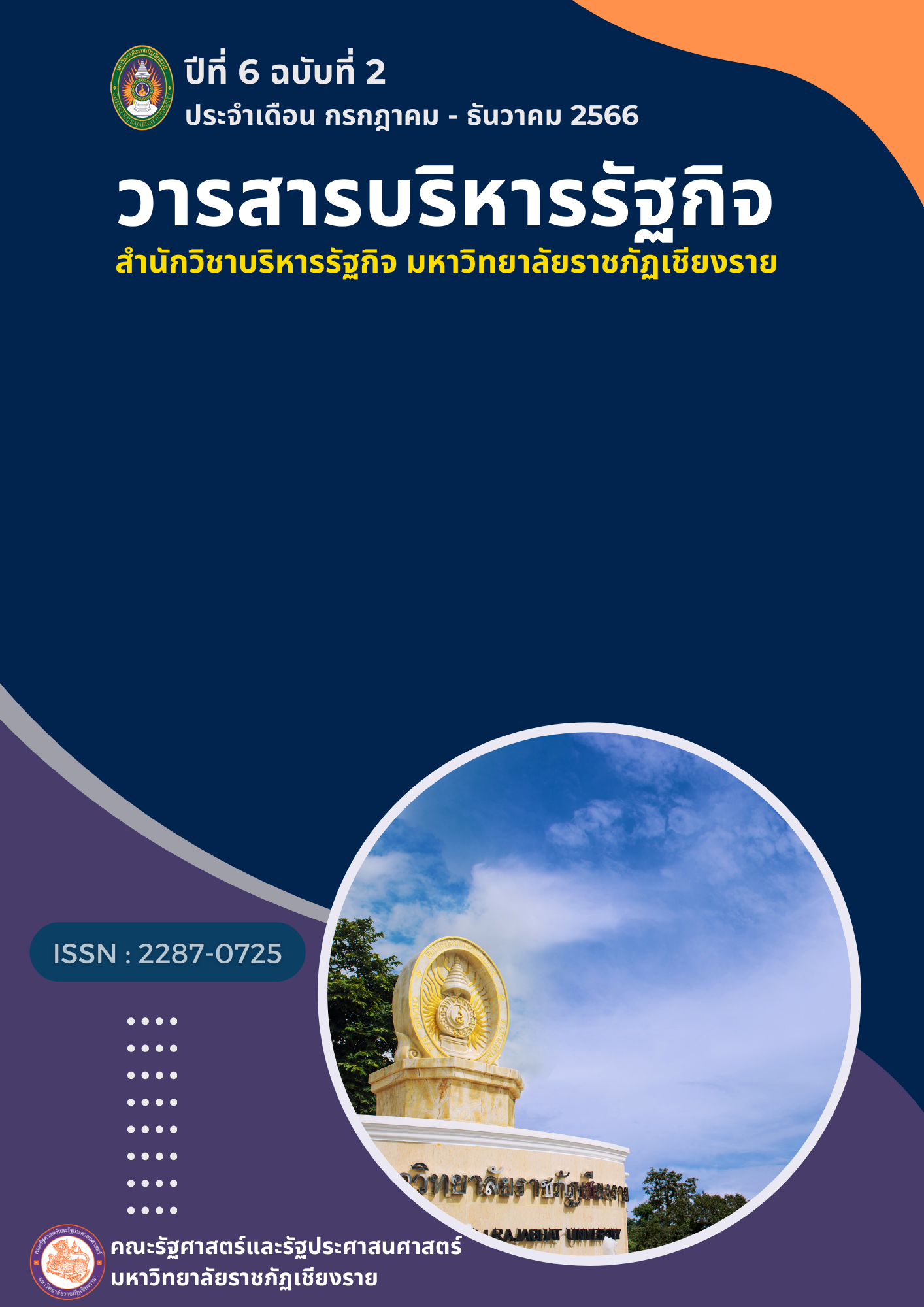การพัฒนาศักยภาพการสร้างมูลค่าเพิ่มในผลิตภัณฑ์ของผู้ประกอบการวิสาหกิจชุมชนในจังหวัดนนทบุรีของประเทศไทย
Main Article Content
บทคัดย่อ
บทความวิชานี้มีวัตถุประสงค์คือ เพื่อศึกษาการพัฒนาศักยภาพการสร้างมูลค่าเพิ่มในผลิตภัณฑ์ของผู้ประกอบการวิสาหกิจชุมชน ในจังหวัดนนทบุรีของประเทศไทย โดยมีการพัฒนาศักยภาพในครั้งนี้แบ่งเป็น 4 ขั้นตอนคือ 1) ความสำคัญของการวัดการพัฒนาศักยภาพการสร้างมูลค่าเพิ่มในผลิตภัณฑ์ 2) การวัดการพัฒนาศักยภาพการสร้างมูลค่าเพิ่มในผลิตภัณฑ์ 3) องค์ประกอบของการพัฒนาศักยภาพการสร้างมูลค่าเพิ่มในผลิตภัณฑ์ และ 4) ดัชนีชี้วัดองค์ประกอบการพัฒนาศักยภาพการสร้างมูลค่าเพิ่มในผลิตภัณฑ์ของผู้ประกอบการวิสาหกิจชุมชน ได้แก่ (1) ปัจจัยด้านผลิตภัณฑ์ (2) ปัจจัยด้านกระบวนการ (3) ปัจจัยด้านการปฏิบัติงานของพนักงาน (4) ปัจจัยด้านการเรียนรู้ส่วนบุคคล (5) ปัจจัยด้านค่าตอบแทนของสมาชิกของวิสาหกิจชุมชน (6) ปัจจัยด้านการยอมรับเทคโนโลยีสารสนเทศ กับ (7) ปัจจัยด้านการจัดวางกลยุทธ์
Article Details
เอกสารอ้างอิง
เชาวนี แย้มผิว และจันทนา แสนสุข. (2564). กลยุทธ์เศรษฐกิจสร้างสรรค์ของผู้ประกอบการวิสาหกิจขนาดกลางและขนาดย่อมในจังหวัดพระนครศรีอยุธยา. วารสารวิชาการวิทยาลัยสันตพล, 7(1), 39-49.
ณัฐวุฒิ วิเศษ. (2555). ปัจจัยในการดำเนินธุรกิจของการเป็นผู้ประกอบการธุรกิจขนาดกลางและขนาดย่อม (SMEs) จังหวัดนนทบุรี. การวิจัยครั้งนี้ได้รับทุนอุดหนุนการวิจัยจากวิทยาลัยราชพฤกษ์ ปีการศึกษา 2555.
สำนักงานส่งเสริมวิสาหกิจขนาดกลางและขนาดย่อม. (2561). รายงานสถานการณ์ SME ปี 2561. สำนักงานคณะกรรมการพัฒนาการเศรษฐกิจและสังคมแห่งชาติ. แหล่งที่มา https://www.sme.go.th/upload/mod_download/download-20180912113024.pdf.
Alam, I. (2006). Removing the fuzziness from the fuzzy front-end of service innovations through customer interactions. Industrial marketing management, 35(4), 468-480.
Bruque, S., & Moyano, J. (2007, 27 May). OrganisationalDeterminants of Information TechnologyAdoption and Implementation in SMEs: The Case of Family and Cooperative Firms. Technovation.
Camisón, C., & Monfort-Mir, V. M. (2012). Measuring innovation in tourism from the Schumpeterian and the dynamic-capabilities perspectives. Tourism management, 33(4), 776-789.
Chan, D. (1998). Functional Relations among Constructs in the Same Content Domain at Different Levels of Analysis: A Typology of Composition Models. Journal of Applied Psychology, 83(2), 234-246.
Chen, J. S., & Tsou, H. T. (2007). Information technology adoption for service innovation practices and competitive advantage: The case of financial firms. Information research: an international electronic journal, 12(3), 3.
Damanpour, F. & Gopalakrishnan, S. (2001). The Dynamics of the Adoption of Product and Process Innovations in Organizations. Journal of Management Studies, 38(1), 65-84.
Djellal, F., & Gallouj, F. (2010). Services, innovation and performance: general presentation. Journal of Innovation Economics Management, (1), 5-15.
Droege, H., Hildebrand, D., & Heras Forcada, M. A. (2009). Innovation in services: present findings, and future pathways. Journal of Service Management, 20(2), 131-155.
Evangelista, R., & Savona, M. (2003). Innovation, employment and skills in services. Firm and sectoral evidence. Structural Change and Economic Dynamics, 14(4), 449-474.
Gallouj, F. & Savona, M. (2009). Innovation in service: a review of the debate and a research agenda. J Evo Econ, 19, 149-172.
Hall, C. M., & Williams, A. (2008). Tourism and innovation. Routledge.
Hipp, C., & Grupp, H. (2005). Innovation in the service sector: The demand for service-specific innovation measurement concepts and typologies. Research policy, 34(4), 517-535.
Hjalager, A. M. (2010). A review of innovation research in tourism. Tourism management, 31(1), 1-12.
Kirton, J. J., & Cooper, A. F. (2009). Innovation in Global health Governance. Innovation in Global Health Governance: Critical Cases.
Li, Y., Liu, Y., Duan, Y., & Li, M. (2008). Entrepreneurial orientation, strategic flexibilities and indigenous firm innovation in transitional China. International journal of technology management, 41(1-2), 223-246.
O’Cass, A., Song, M. & Yuan, L. (2012). Anatomy of service innovation: Introduction to the special issue. Journal of Business Research, 66(8), 1060-1062.
OECD. (2008). Tourism in OECD Countries: Trends and Policies. Paris: OECD Publishing.
Oke, A. (2007). Innovation types and innovation management practices in service companies. International Journal of Operations & Production Management, 27(6), 564-587.
Ordanini, A., & Parasuraman, A. (2011). Service innovation viewed through a service-dominant logic lens: a conceptual framework and empirical analysis. Journal of Service Research, 14(1), 3-23.
Pires, C. P., Sarkar, S., & Carvalho, L. (2008). Innovation in services–how different from manufacturing?. The Service Industries Journal, 28(10), 1339-1356.
Schumpeter, J. (1934). The Theory of Economic Development. (reproduced, New York: 1961). Cambridge: Harvard University Press.
Sundbo, J. (1997). Management of innovation in services. Service Industries Journal, 17(3), 432-455.
Uchupalanan, K. (2000). Competition and IT-based Innovation in Banking Services. International Journal of Innovation Management, 4(4), 455-489.
Vermeulen, P. A. M., O’shaughnessy, K. C., & De Jong, J. P. J. (2003). Innovation in SMEs: An empirical investigation of the input-throughput-output-performance model. EIM, Zoetermeer.
Weiermair, K. (2006). Prospects for innovation in tourism: Analyzing the innovation potential throughout the tourism value chain. Journal of Quality Assurance in Hospitality & Tourism, 6(3-4), 59-72.
Weng, M. H., Ha, J. L., Wang, Y. C., & Tsai, C. L. (2012). A study of the relationship among service innovation, customer value and customer satisfaction: An empirical study of the hotel industry in Taiwan. International Journal of Organizational Innovation, 4(3), 98-112.
Wu, C. H., Parker, S. K., & De Jong, J. P. (2014). Need for cognition as an antecedent of individual innovation behavior. Journal of Management, 40(6), 1511-1534.
Ye, B. H., Qiu, H. Z., & Yuen, P. P. (2011). Motivations and experiences of Mainland Chinese medical tourists in Hong Kong. Tourism Management, 32(5), 1125-1127.


